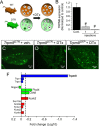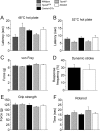A sensory-labeled line for cold: TRPM8-expressing sensory neurons define the cellular basis for cold, cold pain, and cooling-mediated analgesia
- PMID: 23407943
- PMCID: PMC3711390
- DOI: 10.1523/JNEUROSCI.1943-12.2013
A sensory-labeled line for cold: TRPM8-expressing sensory neurons define the cellular basis for cold, cold pain, and cooling-mediated analgesia
Abstract
Many primary sensory neurons are polymodal, responding to multiple stimulus modalities (chemical, thermal, or mechanical), yet each modality is recognized differently. Although polymodality implies that stimulus encoding occurs in higher centers, such as the spinal cord or brain, recent sensory neuron ablation studies find that behavioral responses to different modalities require distinct subpopulations, suggesting the existence of modality-specific labeled lines at the level of the sensory afferent. Here we provide evidence that neurons expressing TRPM8, a cold- and menthol-gated channel required for normal cold responses in mammals, represents a labeled line solely for cold sensation. We examined the behavioral significance of conditionally ablating TRPM8-expressing neurons in adult mice, finding that, like animals lacking TRPM8 channels (Trpm8(-/-)), animals depleted of TRPM8 neurons ("ablated") are insensitive to cool to painfully cold temperatures. Ablated animals showed little aversion to noxious cold and did not distinguish between cold and a preferred warm temperature, a phenotype more profound than that of Trpm8(-/-) mice which exhibit only partial cold-avoidance and -preference behaviors. In addition to acute responses, cold pain associated with inflammation and nerve injury was significantly attenuated in ablated and Trpm8(-/-) mice. Moreover, cooling-induced analgesia after nerve injury was abolished in both genotypes. Last, heat, mechanical, and proprioceptive behaviors were normal in ablated mice, demonstrating that TRPM8 neurons are dispensable for other somatosensory modalities. Together, these data show that, although some limited cold sensitivity remains in Trpm8(-/-) mice, TRPM8 neurons are required for the breadth of behavioral responses evoked by cold temperatures.
Figures








Similar articles
-
Enhanced behavioral responses to cold stimuli following CGRPα sensory neuron ablation are dependent on TRPM8.Mol Pain. 2014 Nov 19;10:69. doi: 10.1186/1744-8069-10-69. Mol Pain. 2014. PMID: 25406633 Free PMC article.
-
The cellular code for mammalian thermosensation.J Neurosci. 2013 Mar 27;33(13):5533-41. doi: 10.1523/JNEUROSCI.5788-12.2013. J Neurosci. 2013. PMID: 23536068 Free PMC article.
-
Role of TRPM8 Channels in Altered Cold Sensitivity of Corneal Primary Sensory Neurons Induced by Axonal Damage.J Neurosci. 2019 Oct 9;39(41):8177-8192. doi: 10.1523/JNEUROSCI.0654-19.2019. Epub 2019 Aug 30. J Neurosci. 2019. PMID: 31471469 Free PMC article.
-
TRPM8: from cold to cancer, peppermint to pain.Curr Pharm Biotechnol. 2011 Jan 1;12(1):68-77. doi: 10.2174/138920111793937961. Curr Pharm Biotechnol. 2011. PMID: 20932257 Review.
-
Scraping through the ice: uncovering the role of TRPM8 in cold transduction.Am J Physiol Regul Integr Comp Physiol. 2011 Jun;300(6):R1278-87. doi: 10.1152/ajpregu.00631.2010. Epub 2011 Mar 16. Am J Physiol Regul Integr Comp Physiol. 2011. PMID: 21411765 Free PMC article. Review.
Cited by
-
AMG2850, a potent and selective TRPM8 antagonist, is not effective in rat models of inflammatory mechanical hypersensitivity and neuropathic tactile allodynia.Naunyn Schmiedebergs Arch Pharmacol. 2015 Apr;388(4):465-76. doi: 10.1007/s00210-015-1090-9. Epub 2015 Feb 10. Naunyn Schmiedebergs Arch Pharmacol. 2015. PMID: 25662185 Free PMC article.
-
Peripheral Sensory Neurons Expressing Melanopsin Respond to Light.Front Neural Circuits. 2016 Aug 10;10:60. doi: 10.3389/fncir.2016.00060. eCollection 2016. Front Neural Circuits. 2016. PMID: 27559310 Free PMC article.
-
ThermoTRPs and Pain.Neuroscientist. 2016 Apr;22(2):171-87. doi: 10.1177/1073858414567884. Epub 2015 Jan 21. Neuroscientist. 2016. PMID: 25608689 Free PMC article. Review.
-
Sex differences in thermoregulation in mammals: Implications for energy homeostasis.Front Endocrinol (Lausanne). 2023 Mar 8;14:1093376. doi: 10.3389/fendo.2023.1093376. eCollection 2023. Front Endocrinol (Lausanne). 2023. PMID: 36967809 Free PMC article. Review.
-
A novel spinal neuron connection for heat sensation.Neuron. 2022 Jul 20;110(14):2315-2333.e6. doi: 10.1016/j.neuron.2022.04.021. Epub 2022 May 12. Neuron. 2022. PMID: 35561677 Free PMC article.
References
-
- Abrahamsen B, Zhao J, Asante CO, Cendan CM, Marsh S, Martinez-Barbera JP, Nassar MA, Dickenson AH, Wood JN. The cell and molecular basis of mechanical, cold, and inflammatory pain. Science. 2008;321:702–705. - PubMed
-
- Babes A, Zorzon D, Reid G. Two populations of cold-sensitive neurons in rat dorsal root ganglia and their modulation by nerve growth factor. Eur J Neurosci. 2004;20:2276–2282. - PubMed
-
- Bautista DM, Jordt SE, Nikai T, Tsuruda PR, Read AJ, Poblete J, Yamoah EN, Basbaum AI, Julius D. TRPA1 mediates the inflammatory actions of environmental irritants and proalgesic agents. Cell. 2006;124:1269–1282. - PubMed
-
- Bautista DM, Siemens J, Glazer JM, Tsuruda PR, Basbaum AI, Stucky CL, Jordt SE, Julius D. The menthol receptor TRPM8 is the principal detector of environmental cold. Nature. 2007;448:204–208. - PubMed
Publication types
MeSH terms
Substances
Grants and funding
LinkOut - more resources
Full Text Sources
Other Literature Sources
Medical
Molecular Biology Databases
